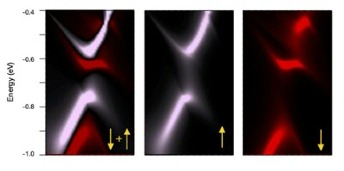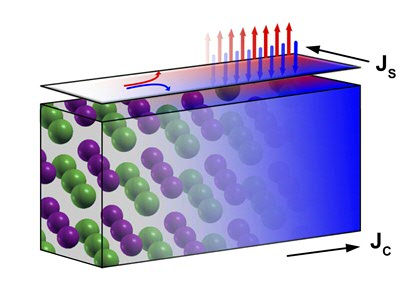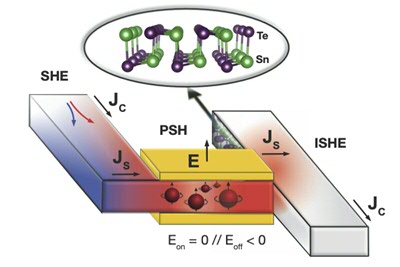Computational materials science
Welcome to the website of the Computational Materials Science Group.
The team of dr. Jagoda Sławińska performs theoretical research focused on the design of novel materials and devices, whose functionalities emerge from the rich physics of spin-orbit interaction. In order to simulate structural, electronic, magnetic and transport properties of materials, we use computational approaches based on density functional theory complemented by tight-binding PAO Hamiltonians, Green’s functions methods and symmetry analysis. Current studies explore surfaces, thin films and hybrid structures, such as interfaces or van der Waals heterostructures, hosting quantum or topological phases that can be controlled by external stimuli. Below, we describe the main research areas and fields of expertise.
Spin-resolved electronic structures
Studies of spin-resolved electronic structures along with the crystal symmetry analysis, allows us to explore novel mechanisms of spin control that can be employed in spintronics devices. One example is non-volatile electric control of Rashba spin texture recently observed in GeTe or manipulation of persistent spin helix predicted for 2D SnTe.

Simulated spin textures can provide useful support for spin- and angle-resolved photoemission spectroscopy, confirming spin polarization of bands in topological materials or helping identify Fermi arcs in Weyl semimetals. The calculations based on the Green’s functions approach allow us to simulate spin-resolved spectra with an unprecedented accuracy.
Charge-to-spin conversion

Employing electron’s spin in electronic devices requires efficient generation and detection of spins via spin and charge conversion. While the principles of well-known conversion mechanisms, such as Rashba-Edelstein and spin Hall effects are rather well understood, they may manifest in an unconventional way in some quantum materials, including two-dimensional heterostructures, topological insulators, Weyl semimetals, ferroelectrics or superconductors. In-depth understanding of these phenomena is essential for design of novel spintronics devices, thus constitutes an important goal of our research.
Ferroelectric control of spin degrees of freedom
Materials that simultaneously possess ferroelectric and ferromagnetic order, so-called magnetoelectric multiferroics, enable controlling magnetism using external electric fields and vice versa. We currently explore these properties towards novel electronic devices beyond CMOS.

We also extensively investigate a novel class of non-magnetic materials known as ferroelectric Rashba semi-conductors (FERSC). The polar axis intrinsically present in these crystals breaks the inversion symmetry and induces spin splitting of bulk bands. The spin texture can be thus switched by an electric field in a non-volatile way. Such functionalities open up an interesting perspective to construct logic-in-memory spintronics devices.
Two-dimensional materials for spintronics and beyond
We perform large-scale computational studies of two-dimensional (2D) materials towards spintronics applications. In particular, we study spin textures, spin-to-charge conversion and coupling between different degrees of freedom, based on the ab initio calculations and symmetry analysis for hundreds of existing and hypothetical crystals. We aim on finding materials that combine multiple functionalities, useful to design all-in-one devices for spintronics and nanoelectronics. Finally, we study van der Waals heterostructures, also including exotic phenomena emerging from their moiré patterns.

| Last modified: | 11 March 2022 5.43 p.m. |
